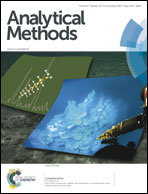The influence of surface composition of quantum dots fluorescence sensing on the discriminative detection of bivalent Mn and Cu cations†
Abstract
Investigating the chemical reactions at the surface of quantum dots (QDs) is fundamental for applications of QDs in ionic environments. On the basis of our recent report about the discriminative detection of Mn(II) from Cu(II) via QD fluorescence sensing, we herein focused on the QD surface chemical reactions with Mn(II) or Cu(II) at different QD surface modification conditions. Two types of QDs were used. One is well modified QDs with a surface rich in Cd-ligands complexes. Another is moderately modified QDs with both bared Te atoms and Cd-ligand complexes on the surface. Our results indicated that well modified QDs underwent a chemical reaction with Cu(II), namely, the substitution of Cd from QDs by Cu(II). In this case, the results of discriminative detection of Mn(II) from Cu(II) is always believable. For moderately modified QDs in comparison, it appears there is a new reaction manner via combination of bared Te atoms with Cu(II) or Mn(II). This new reaction manner occurs mainly around pH 10.3. Consequently, the results of discriminative detection of Mn(II) from Cu(II) via moderately modified QDs is not believable.


 Please wait while we load your content...
Please wait while we load your content...